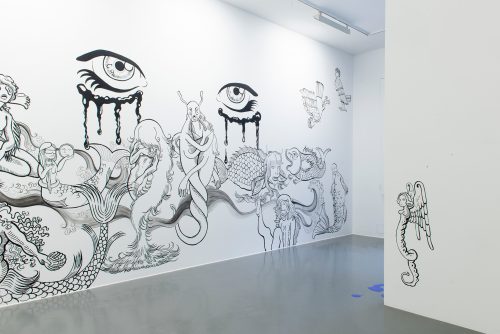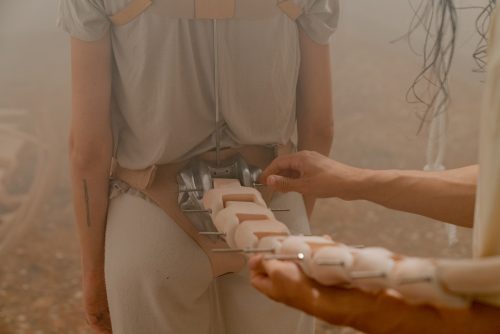
Ndayé Kouagou
Ndayé Kouagou at Sundy

Advertisement










“If you were looking for direction, this is definitely not the place” – spell the billboard-sized words on the gallery walls. The message doesn't sound reassuring, yet it offers a warning, suggesting that there could be more to it. Conundrums and contradictions are typical in Ndayé’s work. Encountering his texts (orally recited in one of his live or video performances and embedded in sculptures and installations) can feel like a riddle to be solved.
My first encounter with Ndayé was five years ago. I had recently moved to a new city and did not know many people. Ndayé and I started talking while queuing for a drink, but when it was time to order, he revealed that he didn't want anything. I was confused. Was he queuing for the sake of it? Over time, things became clear: it was to start a conversation.
I speak of Ndayé, ‘the real person’, to tell of Ndayé, ‘the artist’, ‘the performer’, because the distinction between self, actor, and character is almost indistinguishable in his practice. In his videos, usually less than ten minutes long, a single character - always acted by Ndayé, speaking in a dubbed female voice with subtitles - starts spiralling monologues from something seemingly small, like a coin, to tackle big subjects, such as power, belief, and freedom. With off-kilter wordplay and double entendres, ‘the character’ introduces questions without giving clear answers. He strives for transparency and yet incites doubt. Means appear to have no ends. Or, at least, not immediately.
In the exhibition, an invitation to look further - and across various dimensions - is the video a coin is a coin. Candidly speaking into the camera, the artist wishes to clear a misunderstanding and offer advice. He points out what has not worked: ‘looking at two sides of the same coin is not exactly looking elsewhere’; how difficult it is ‘to change’; and how powerful ‘change’ is. Is he a motivational speaker? An influencer? A preacher? An actor? But most of all: is he for real?
Impersonating a figure that could emerge from the news and entertainment, Ndayé performs a specific kind of wayfinding. The artist prompts the question of movement and triggers spatial interrogation, not so much about where one is going, but where one stands – how one ‘looks’ and sees things. The video questions the position of viewers and their inherent biases. One way in which it does this is via dubbing. Speaking in ‘standard English’, the orator may be more credible and trustworthy, making the message ‘universal’. Another is via clothing: the character wears a blazer and tie, which point to formality. Yet, the garments are off-sized and deconstructed. He also wears flashy eyeshadow and one earring only. In the studio where he moves, the unconcealed tripods and backgrounds point to a dissolution of boundaries: between what’s on stage and behind the scenes, inner and societal, truthful and constructed.
By playing a double of himself and remixing visual and cultural traits, Ndayé moves through various linguistic and aesthetic codes, showing how he can be one and many. He seems to enact what art historian Claire Lambert-Beatty names ‘parafictions’ – those narrative ploys whereby artists perform other versions of themselves, which confound cultural desires to order, categorise and ‘make sense’ of complex narratives. These strategies, Lambert-Beatty explains, ‘train us in scepticism and doubt, but also, oddly, in belief’. To change course when confronted by a system that claims order and binaries, Ndayé embraces a parafictional persona where self and character merge into multiplicity. He morphs and shapeshifts. He changes his outfits and posture. He goes nowhere and anywhere, blurry and unbound.
Ndayé knows that language controls and captures. Like his visual appearance, his speech oscillates between layers of clarity and opacity, irony and seriousness, wanting to pin down meaning and establish concrete truths while counteracting the necessities of uncertainty. A coin is just a coin - but also a catalyst for conversation. ‘Change’ is action but also a tool, a metaphor to switch viewpoints.
Like the artist says in his video: orality is vital. Even if there isn’t a clear direction or a plot, but feelings and intricate thoughts, Ndayé showed me (in a bar one night and consistently in his work) that to get lost in words is to find multiple ways. It’s about the dialogue and entering the room where one can be. The many dimensions a person can inhabit.
Giulia Civardi




